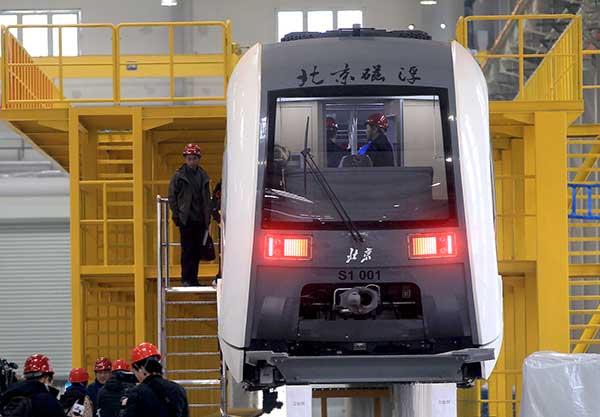
A maglev train for Beijing's new S1 line on Sunday. The maglev line is expected to start operation by the end of next year. Cheng Gong / For China Daily
Beijing's first rail line using magnetic levitation technology is scheduled to start running next year, with engineers now testing the new trains, city officials announced on Sunday.
The overhead maglev line, named S1, will run in the west, from Shijingshan district's Pingguoyuan to Shimenying in the mountainous Mentougou district. It will stretch about 10 kilometers and have eight stations.
The travel time between the two locations, currently connected only by bus, will be cut by two-thirds to just 20 minutes, according to an anonymous official from the Beijing Major Projects Construction Office quoted by Beijing Daily.
"It will take only the time it takes to eat a fast-food meal to travel the entire line," he said. "Plus, the maglev train is more stable, quieter and better at climbing hills compared with normal trains."
Once finished, S1 will connect with the subway's Line 1 and the western extension of Line 6, which is under construction.
Built in neighboring Hebei province, the first maglev train was delivered to the capital on Dec 16. According to officials, the line will have 10 trains, each with a capacity of 1,000 passengers.
The line will make scenic spots in Beijing's western suburbs more easily accessible to residents and tourists.
"As much as I enjoy the serenity there, it takes me about two hours by bus to go to Tanzhe and Jietai temples in Mentougou," said Liu Bo, 25, who lives in the city. "When the new line opens, I can go to the temples more often.
"It's been a while since the work began, so all I hope now is that it opens soon."
Construction on S1 began in 2011 after months of debate, with public fears raised about potential radiation. However, experts have dismissed such concerns.
"The line employs closed magnetic field technology that elevates the train about 1 centimeter above the track to reduce friction. It leaks no magnetic influence outside the controlling 'red line' distance, therefore it won't affect nearby residents," Li Jie, chief engineer of the maglev project, told Beijing Daily.
"As for passengers inside the train, as the radiation is non-ionizing like radio waves, it's neither accumulative nor harmful. At most, passengers may feel a bit warmer."
Although rare compared with conventional subway trains, maglev trains are not new to China. A high-speed maglev service has run from Shanghai's Pudong International Airport to downtown Longyang Road since 2002. Trains travel at up 430 km per hour.
A medium-to-low speed maglev line that uses similar technology to Beijing's S1 also opened in May between central Changsha, capital of Hunan province, and the city's international airport.


















































